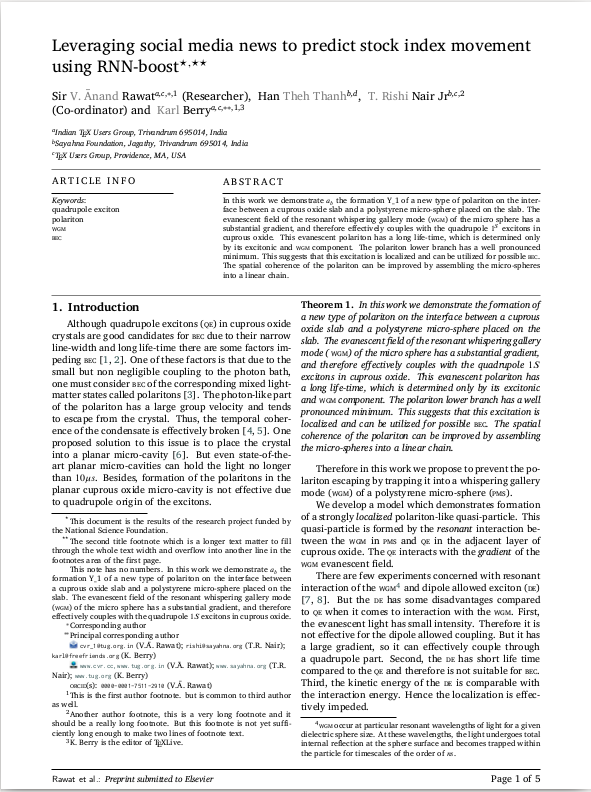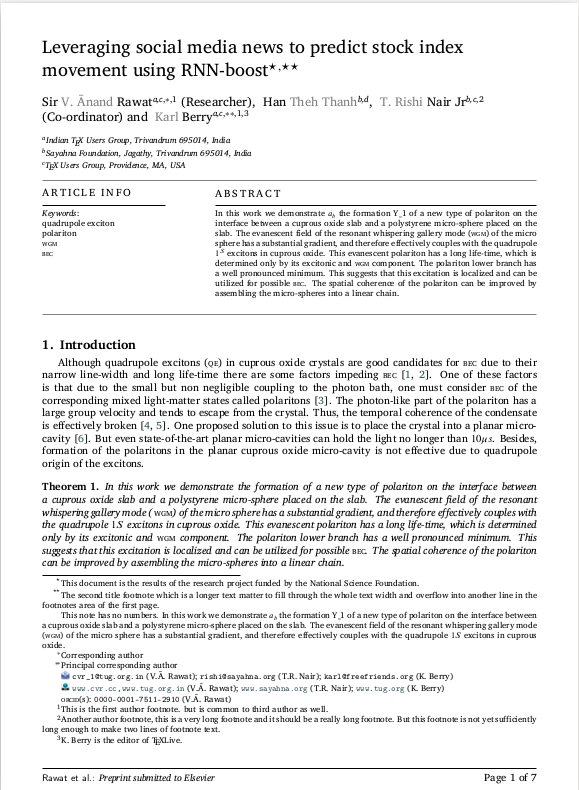Elsarticle - CAS: Difference between revisions
Jump to navigation
Jump to search
(→Tables) |
|||
| Line 196: | Line 196: | ||
</table> | </table> | ||
---- | |||
===Tables=== | ===Tables=== | ||
====Normal tables==== | ====Normal tables==== | ||
Revision as of 11:55, 25 September 2018
Elsarticle - CAS
Class files
Usage
There are two class files
cas-sc.clsfor single column journals.\documentclass[<options>]{cas-sc}
cas-dc.clsfor double column journals.\documentclass[<options>]{cas-dc}
and have an option longmktitle to handle long front matter.
Front matter
\title[mode = title]{Leveraging social media news to predict stock
index movement using RNN-boost}
\tnotemark[1,2]
\tnotetext[1]{This document is the results of the research project
funded by the National Science Foundation.}
\tnotetext[2]{The second title footnote which is a longer text
matter to fill through the whole text width and overflow into
another line in the footnotes area of the first page.}
\author[1,3]{V. {{\=A}}nand Rawat}[type=editor,
auid=000,bioid=1,
prefix=Sir,
role=Researcher,
orcid=0000-0001-7511-2910]
\cormark[1]
\fnmark[1]
\ead{cvr_1@tug.org.in}
\ead[url]{www.cvr.cc,www.tug.org.in}
\credit{Conceptualization of this study, Methodology, Software}
\address[1]{Indian \TeX{} Users Group, Trivandrum 695014, India}
\author[2,4]{Han Theh Thanh}[style=chinese]
\author[2,3] {T. Rishi Nair}[role=Co-ordinator,
suffix=Jr]
\fnmark[2]
\ead{rishi@sayahna.org}
\ead[URL]{www.sayahna.org}
\credit{Data curation, Writing - Original draft preparation}
\address[2]{Sayahna Foundation, Jagathy, Trivandrum 695014, India}
\author[1,3]{Karl Berry}
\cormark[2]
\fnmark[1,3]
\ead{karl@freefriends.org}
\ead[URL]{www.tug.org}
\address[3]{\TeX{} Users Group, Providence, MA, USA}
\cortext[cor1]{Corresponding author}
\cortext[cor2]{Principal corresponding author}
\fntext[fn1]{This is the first author footnote.
but is common to third author as well.}
\fntext[fn2]{Another author footnote, this is a very long footnote
and it should be a really long footnote. But this footnote is not
yet sufficiently long enough to make two lines of footnote text.}
\fntext[fn3]{K. Berry is the editor of \TeX Live.}
\nonumnote{This note has no numbers. In this work we demonstrate
$a_b$ the formation Y\_1 of a new type of polariton on the
interface between a cuprous oxide slab and a polystyrene
micro-sphere placed on the slab. The evanescent field of the
resonant whispering gallery mode (\WGM) of the micro sphere has a
substantial gradient, and therefore effectively couples with the
quadrupole $1S$ excitons in cuprous oxide.}
\begin{abstract}[S U M M A R Y]
In this work we demonstrate $a_b$ the formation Y\_1 of a new type
of polariton on the interface between a cuprous oxide slab and a
polystyrene micro-sphere placed on the slab. The evanescent field of
the resonant whispering gallery mode (\WGM) of the micro sphere has
a substantial gradient, and therefore effectively couples with the
quadrupole $1^S$ excitons in cuprous oxide. This evanescent
polariton has a long life-time, which is determined only by its
excitonic and \WGM component. The polariton lower branch has a well
pronounced minimum. This suggests that this excitation is localized
and can be utilized for possible \BEC. The spatial coherence of the
polariton can be improved by assembling the micro-spheres into a
linear chain.
\end{abstract}
\begin{keywords}
quadrupole exciton \sep polariton \sep \WGM \sep \BEC
\end{keywords}
\maketitle
Title
\title command have the below options:
title: Document titlealt: Alternate titlesub: Sub titletrans: Translated titletranssub: Translated sub title
\title[mode=title]{This is a title}
\title[mode=alt]{This is a alternate title}
\title[mode=sub]{This is a sub title}
\title[mode=trans]{This is a translated title}
\title[mode=transsub]{This is a translated sub title}
\tnotemark[1,2]- Title note marking
\tnotetext[1]{Title notes}- Title note
Author
\author command have the below options:
auid: Author idbioid: Biography idalt: Alternate authorstyle: Style of author namechineseprefix: PrefixSirsuffix: Suffixdegree: Degreerole: Roleorcid: ORCIDcollab: Collaborationanon: Anonymous authordeceased: Deceased authortwitter: Twitter accountfacebook: Facebook accountlinkedin: LinkedIn accountplus: Google plus accountgplus: Google plus account
\author[1,3]{Editor}[type=editor,
auid=000,bioid=1,
prefix=Sir,
role=Researcher,
orcid=0000-0001-7511-2910,
facebook=Editor,
twitter=Editor,
linkedin=Editor,
gplus=Editor]
|
- Email id
\ead{email@mailserver.com}- URL address
\ead[url]{www.urladdress.com}
Abstract and Keywords
\begin{abstract}
This is a abstract. \lipsum[3]
\end{abstract}
\begin{keywords}
First keyword \sep Second keyword \sep Third keyword \sep Fourth keyword
\end{keywords}
|
Tables
Normal tables
\begin{table}
\caption{This is a test caption.}
\begin{tabular*}{\tblwidth}{@{} LLLL@{} }
\toprule
Col 1 & Col 2\\
\midrule
12345 & 12345\\
12345 & 12345\\
12345 & 12345\\
12345 & 12345\\
12345 & 12345\\
\bottomrule
\end{tabular*}
\end{table}
|
Span tables
\begin{table*}[width=.9\textwidth,cols=4,pos=h]
\caption{This is a test caption.}
\begin{tabular*}{\tblwidth}{@{} LLLLLL@{} }
\toprule
Col 1 & Col 2 & Col 3 & Col4 & Col5 & Col6 & Col7\\
\midrule
12345 & 12345 & 123 & 12345 & 123 & 12345 & 123 \\
12345 & 12345 & 123 & 12345 & 123 & 12345 & 123 \\
12345 & 12345 & 123 & 12345 & 123 & 12345 & 123 \\
12345 & 12345 & 123 & 12345 & 123 & 12345 & 123 \\
12345 & 12345 & 123 & 12345 & 123 & 12345 & 123 \\
\bottomrule
\end{tabular*}
\end{table*}
|
Biography
Normal biography
\begin{biography}[tuglogo.png]{Biography}
The evanescent polariton provided by a single sphere gives the
time coherence necessary for the observable \BEC of the quadrupole
exciton. But the spatial coherence is limited to a small region
near the sphere. To improve the spatial coherence one has to
sacrifice the temporal coherence slightly by delocalizing the
corresponding \WGM. It can be done by using an array of spheres
aligned along the $z$ direction and separated by the distance
$\delta r_{0}$ (See Fig.\ref{FIG:2}).
\end{biography}
Custom biography
\bio[width=10mm,pos=l]{tuglogo.png}
\textbf{Another Biography:}
Recent experimental \cite{HARA:2005} and theoretical
\cite{DEYCH:2006} studies have shown that the \WGM can travel
along the chain as "heavy photons". Therefore the \WGM acquires
the spatial dispersion, and the evanescent quadrupole polariton
has the form (See Fig.\ref{FIG:3}):
\endbio




